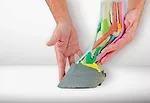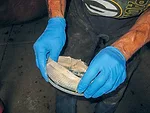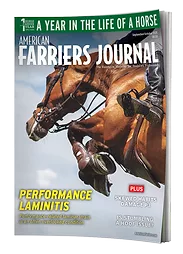Advertise Follow Us
American Farriers Journal

View Archived Issues
April 2015
Volume: 41
Edition: 3
American Farriers Journal is the “hands-on” magazine for professional farriers, equine veterinarians and horse care product and service buyers.
-
Table Of Contents
Table Of Contents
American Farriers Journal Launches New Website
Featuring a clean, organized look with easily searchable content, americanfarriers.com is the largest depository of American Farriers Journal information on the Internet with new features and upgradesRead MoreGet Help with an Unruly Horse
A veterinarian describes how the Dormosedan Gel sedative works and gives tips for handling the drug safely and effectivelyRead MoreHelping Horses With Hoof Packing
Manufacturer representatives and farriers share suggestions for success when using various products and educating ownersRead MoreHow To Match Nails To Your Horseshoes
Considering these points when selecting which nail to use will result in making a better choiceRead MoreModify Your Tools To Fit Your Needs
Simple tweaks to your equipment can improve safety and efficiencyRead MoreFind A Place For Synthetics In Your Shoeing Arsenal
Sometime in its lifetime, every horse may benefit from wearing a synthetic shoeRead MoreQuicked Horse Unleashes “Cascade Of Events”
Colorado duo wades through abscesses, undermined soles and a difficult ownerRead MoreProduct InnovationHow 3D Printing is Advancing Hoof Care
This technology aids the understanding of anatomy and shows promise with improving equine healthRead MoreTaking The Load Off Sheared Heels
Understand what is happening, why it’s happening and how severe the problem is before forming a planRead MoreHelping Clients Pay Attention to Nutrition Needs
Here are 10 easy-to-implement tips to describe to your footcare clients the hows and whys of equine nutritionRead MoreProtecting Your Hearing
While everyone loses some hearing as they age, farriers are at an increased risk for hearing loss if not properly protectedRead MoreShop TalkAFA Celebrates 44th Annual Convention
25 Quick Tips for Improving a Practice
Three farriers share ideas for improvement that can be immediately built into a farrier practiceRead MoreSlip & Grip — It Is A Fine Line
Understanding how shoe material affects slip and grip influences how much traction a horse needs.Read MoreHow To Get Owners To Join The Hoof-Care Team
Persistent communication is the key to getting clients involved with their horses’ footcareRead More -
Featured Articles
Featured Articles
Get Help with an Unruly Horse
A veterinarian describes how the Dormosedan Gel sedative works and gives tips for handling the drug safely and effectivelyRead MoreModify Your Tools To Fit Your Needs
Simple tweaks to your equipment can improve safety and efficiencyRead More -
Online Extras
Online Extras











